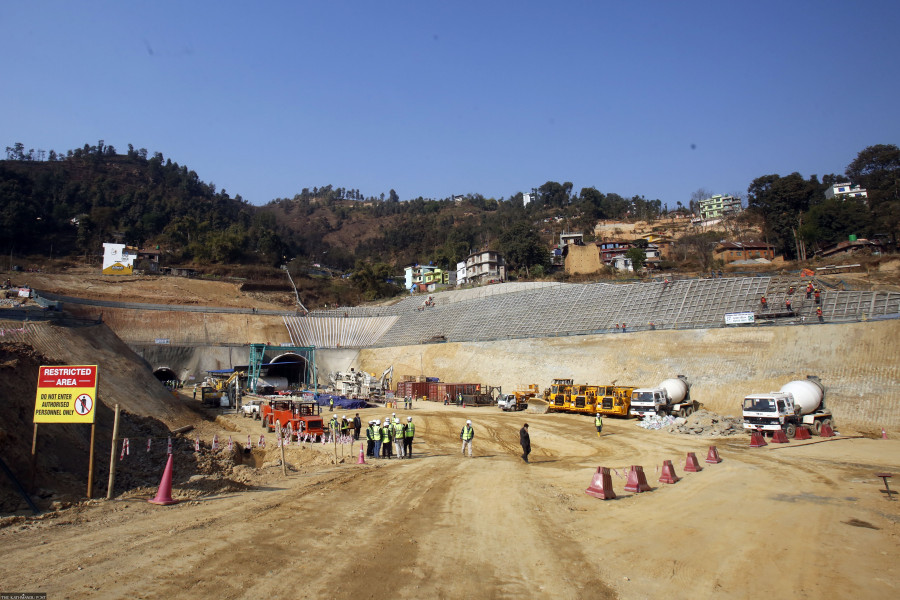Money
Nagdhunga tunnel project deadline extended by a year
Delays caused by Covid-19 among other issues cited for the extension of the completion period to April 25 next year.
Post Report
The government has extended the deadline of Nepal’s first tunnel road project—Nagdhunga Tunnel—to April next year.
The 2.68 kilometres long tunnel project has so far seen about 49 percent of the physical progress, according to an official associated with the project.
The project’s original deadline was April 26, 2023. “The deadline has been extended until April 25 next year due to the delays caused by Covid-19 and other technical issues,” said Madhav Prasad Adhikari, the deputy project chief.
The geological issues faced by the project are also being analysed, according to Adhikari. “The land compensation issue at Balambu, where a flyover is to be built, has also caused hindrance in the project’s work.”
Until February 17, the excavation work was completed for 1,813 metres of the main tunnel and 2,069.8 metres in the evacuation tunnel.
The main and evacuation tunnels will be 2.68 kilometres and 2.55 kilometres long, respectively, when completed.
Being constructed by the Japanese company Hazama-Ando Corporation, the tunnel passes under the western rim of the Kathmandu Valley, allowing motorists to avoid the treacherous hills which face frequent landslides.
With the project’s completion, commuters on the Nagdhunga-Naubise stretch will be able to avoid at least 19 hairpin bends and sharp curves along an 8 km section of the roadway.
According to a 2015 preparatory survey, it takes around 34 minutes to navigate the 8 km section following the route’s existing alignment.
The then Prime Minister KP Sharma Oli laid the foundation stone of the Rs22 billion project in October 2019. It was expected to be completed within three and a half years.
Besides the tunnel from Sisne Khola to Basnetchhap, the project also has a 2.6 km four-lane approach road with a service lane on each side.
Of the total, 2.2 kilometres of the approach road will be from Basnetchhap to Thankot and the rest on the other side of the tunnel.
Around 79 percent of the roadway excavation and 69 percent of embankment filling work has been completed on the access road.
The project was also affected last month after the home ministry issued a circular on January 4 to ban “illegal” crusher plants across the country.
However, the government later allowed the crusher plants to operate temporarily, setting a condition that they have to be registered and pay taxes by mid-July this year, after a shortage of riverbed materials like sand and gravel hit development works.
“The construction work has picked up pace after the government’s decision,” said Adhikari, the deputy project chief.
The deadline of the project, which was first extended by three months, has been pushed further beyond, by nine months.
“The recent expansion was done following the government’s provision for projects whose agreements happened before the Covid-19 pandemic,” Adhikari said. “We are hopeful that the project will meet the new deadline.”
In 2016, the Japanese government agreed to provide a soft loan of Rs15.28 billion for the tunnel to eliminate the need to travel the circuitous route over the Valley’s western rim, which is the main overland link between the capital and the southern plains.
Its repayment period is 40 years, including a grace period of 10 years when the government will not have to pay any interest or repayment instalments.
Following the end of the grace period, the government will have to pay annual interest at the rate of 0.01 percent.
It will also have LED lighting, mechanical ventilation, an evacuation tunnel door and emergency telephone service.
The approach road will have three bridges, toll booths and a roadside rest area for travellers.
The rest area, spread over 4,650 square metres, will have a parking space for nine heavy vehicles and 23 light vehicles, fast food restaurants, shops and toilets.




 7.12°C Kathmandu
7.12°C Kathmandu













